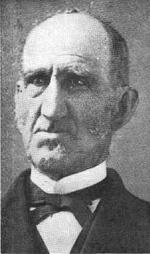Alvin T. Smith
Alvin T. Smith | |
|---|---|
 Portrait of Smith | |
| Probate Judge of Washington County, Oregon | |
| In office 1851 | |
| Constituency | Washington County |
| Magistrate for the Provisional Government of Oregon | |
| In office 1843–1844 | |
| Constituency | Twality District |
| Personal details | |
| Born | November 17, 1802 Branford, Connecticut |
| Died | January 22, 1888 (aged 85) Forest Grove, Oregon |
| Spouse(s) | Abigail Raymond (1840-1858) Jane Averill (1869-1888) |
| Occupation | carpenter |
Alvin Thompson Smith (November 17, 1802 – January 22, 1888) was an American missionary and politician in what became the state of Oregon. A native of Connecticut, he lived in Illinois before moving to the Oregon Country to preach to the Native Americans in the Tualatin Valley. There he served in both the Provisional Government of Oregon and the government of the Oregon Territory, as well as helping to establish Tualatin Academy, later becoming Pacific University. Smith's former home, the Alvin T. Smith House in Forest Grove, is listed on the National Register of Historic Places.
Early years
Alvin Thompson Smith was born in
Oregon
The group traveled first to
After arriving in the Oregon Country in September, the group wintered at Henry H. Spalding’s mission in what is now Eastern Washington.[1][4] At the mission Smith assisted in building saw mills, a grist mill, and what was the first spinning wheel and loom in what became the Oregon Territory.[1] He remained for nearly a year before leaving in September 1841 for the Willamette Valley.[2]
Smith settled on the Tualatin Plains near what became Forest Grove, Oregon.[2] He and his wife were the first permanent Euro-American settlers at what would become Forest Grove.[5] There he built a log cabin on his 643 acres (260 ha) farm and later donated to Tabitha Moffatt Brown's orphan school in 1845 that grew to become Tualatin Academy and then Pacific University.[1][6] The couple's first cabin was lost to a flood, but they built a new log cabin on the farmstead.[7]
Political career
In May 1843, he participated in the Champoeg Meetings where pioneers debated on whether to create an independent government for the Oregon Country prior to the settlement of the Oregon boundary dispute. At the meetings, Smith voted for the creation of the Provisional Government of Oregon and was elected as a magistrate for the Twality District, now Washington County.[1] Smith was appointed by the Provisional Legislature of Oregon as a road viewer for a proposed road from the Willamette Falls to the Tualatin Plains in 1844.[8] In 1851, he was elected as the probate judge for Washington County and received his commission from Territorial Governor John P. Gaines on July 3, 1851.[8]
Later years

Smith volunteered in 1848 to fight in the
On April 17, 1858, his wife Abigail died, and later that year Smith assisted in building the Forest Grove Congregational Meeting House in September.[8] Smith remarried on October 19, 1869, eleven years after his first wife died.[3][9] Smith traveled home where he married Jane Averill from his hometown of Branford, Connecticut, before returning to Oregon and his farm.[9][11] He and Jane moved into Forest Grove proper in 1870, but continued to own the farm and old home.[7] Alvin Thompson Smith died on January 22, 1888, in Forest Grove at the age of 85 and was buried at Mountain View Memorial Gardens in that city.[1]
References
- ^ a b c d e f g h Corning, Howard M. (1989) Dictionary of Oregon History. Binfords & Mort Publishing. p. 226.
- ^ a b c d e f g h i Clarke, S. A. (1905). Pioneer Days of Oregon History. Portland: J.K. Gill Company. Vol. 2, pp. 449-451.
- ^ a b Raymond, Samuel. (1886). Genealogies of the Raymond families of New England, 1630-1 to 1886: With a Historical Sketch of Some of the Raymonds of Early Times, Their Origin, etc. Press of J.J. Little & co., p. 29.
- ^ a b Gray, William Henry. 1870. A history of Oregon, 1792-1849, drawn from personal observation and authentic information. Portland, Or: Harris & Holman. pp. 188-190.
- ^ Mandel, Michelle. (March 10, 2005) "Restoration begins in earnest at historic house", The Oregonian.
- OCLC 4874569.
- ^ a b c Mandel, Michelle. (May 6, 2003) "Historic house awaits reawakening", The Oregonian.
- ^ a b c “Accessions”, The Oregon Historical Quarterly. Oregon Historical Society, Vol. 6, p. 233. 1905.
- ^ a b c d e Dobbs, C. C. (1932). Men of Champoeg; A Record of the Lives of the Pioneers who Founded the Oregon Government. Portland, Or: Metropolitan Press. pp. 85-87.
- Oregon State Parks and Recreation Department. July 16, 2007. Archived from the original(PDF) on 2011-06-09. Retrieved 2009-05-26.
- ^ Bancroft, H. H., & Victor, M. F. A. F. B. (1886). History of Oregon. San Francisco: The History Co. Vol. 2, p. 762.
